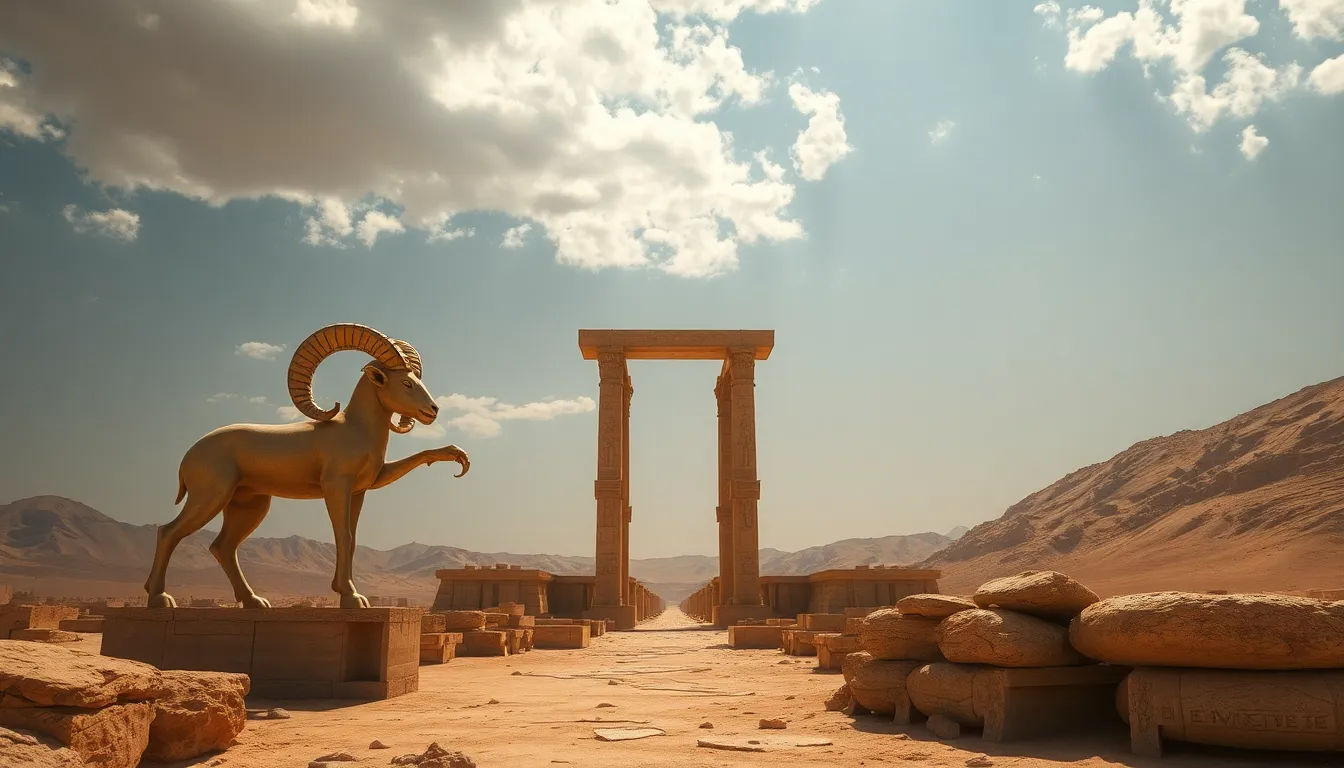The Geography of the Sacred Ram: Myths of Khnum
I. Introduction
Khnum, the ancient Egyptian god of creation and fertility, holds a unique and significant place in Egyptian mythology. Often depicted with the head of a ram, Khnum symbolizes strength and the protective qualities associated with this majestic animal. He was revered as a creator god, believed to shape humans from clay on a potter’s wheel, and his connection to the Nile River further emphasizes his importance in the agricultural practices of ancient Egypt.
This article explores the rich tapestry of myths surrounding Khnum, the symbolism of the sacred ram, and the geographic significance of his worship in ancient Egyptian society. We aim to provide a comprehensive overview of Khnum’s role in mythology and culture, shedding light on his enduring legacy.
II. The Origins of Khnum
Khnum’s worship dates back to the earliest periods of Egyptian civilization, with evidence of his veneration found in the pre-dynastic era. As one of the oldest gods in the Egyptian pantheon, Khnum was originally associated with the Nile’s inundation and the fertility of the land.
According to mythology, Khnum was born from the primordial waters of Nun, and he played a vital role in the creation of humanity. The narratives describe him as a potter who molded the bodies of the living on his wheel, emphasizing his creative powers and connection to the earth.
His association with the Nile is profound; the river not only provided water for agriculture but also represented life itself. Khnum was believed to control the flooding of the Nile, which was essential for the fertility of the land.
III. The Sacred Ram: Symbolism and Significance
The sacred ram holds deep symbolism in ancient Egyptian culture, representing strength, protection, and fertility. This animal was often depicted alongside Khnum, highlighting its significance in his worship.
- Representation of Strength: The ram is a symbol of power and dominance, qualities that Khnum embodied as a creator and protector.
- Role in Agriculture: In agricultural myths, the ram symbolizes the fertility of the fields. Khnum’s blessings were sought for bountiful harvests and the prosperity of crops.
- Influence on Art: The imagery of Khnum as a ram was prevalent in Egyptian art and iconography, showcasing the importance of this deity in religious practices.
IV. Geographic Locations of Khnum Worship
Khnum was primarily worshipped in several key locations in ancient Egypt, with his cult centers playing a significant role in the religious landscape.
- Key Temples: The Temple of Khnum at Esna is one of the most significant sites dedicated to his worship. This temple features intricate carvings and inscriptions that highlight his role as a creator god.
- Nile River Significance: The Nile River’s annual flooding was crucial for agriculture, and Khnum’s association with this natural phenomenon made him a central figure in the fertility of the land.
- Regional Variations: Different regions had variations in how Khnum was venerated, with local myths and practices that reflected their unique relationship with the deity.
V. Myths and Legends Surrounding Khnum
Khnum is central to various myths that illustrate his importance in both creation and the afterlife.
- Creation Myths: In one of the most enduring myths, Khnum is portrayed as a potter who shapes humans from clay. This narrative emphasizes his role in the creation of life and human beings.
- Afterlife Role: Khnum was also believed to assist in the resurrection of the dead, ensuring that souls were reborn in the afterlife, thus connecting him to the cycle of life and death.
- Interactions with Other Deities: Khnum often appeared alongside other gods, such as Ra and Osiris, in various myths, illustrating the interconnectedness of the Egyptian pantheon.
VI. The Cultural Impact of Khnum
Khnum’s influence extended beyond religious practices; he played a crucial role in shaping ancient Egyptian culture and governance.
- Societal Influence: Khnum was integrated into the daily lives of the Egyptians, and his festivals and rituals were significant events that reinforced community and agricultural cycles.
- Reverberations in Later Cultures: The motifs associated with Khnum influenced later cultures and religious practices, demonstrating the enduring nature of his symbolism.
- Contemporary Interpretations: Today, Khnum’s image and stories continue to inspire artists, writers, and scholars, keeping the legacy of this ancient deity alive in modern culture.
VII. Archaeological Discoveries Related to Khnum
Archaeological discoveries have provided valuable insights into the worship of Khnum and the cultural practices surrounding him.
- Important Findings: Excavations at temple sites, such as those at Esna, have uncovered artifacts, inscriptions, and statues dedicated to Khnum, shedding light on his worship.
- Insights from Artifacts: The artifacts found in these sites reveal the artistic styles and religious practices that were prevalent during Khnum’s veneration.
- Preservation Efforts: Ongoing preservation efforts aim to protect these historical sites, ensuring that future generations can study and appreciate the significance of Khnum and his worship.
VIII. Conclusion
In summary, Khnum holds a vital place in Egyptian mythology as a god of creation and fertility. His significance is intricately linked to the sacred ram, which symbolizes strength and protection. The geographic locations of his worship, particularly along the Nile, highlight the deep connection between mythology and the natural world in ancient Egypt.
The enduring legacy of Khnum continues to resonate in contemporary culture, reminding us of the profound impact that geography and mythology have on our understanding of ancient civilizations. Through the exploration of Khnum’s myths and the archaeological discoveries related to his worship, we gain insight into the rich tapestry of Egyptian history and spirituality.




